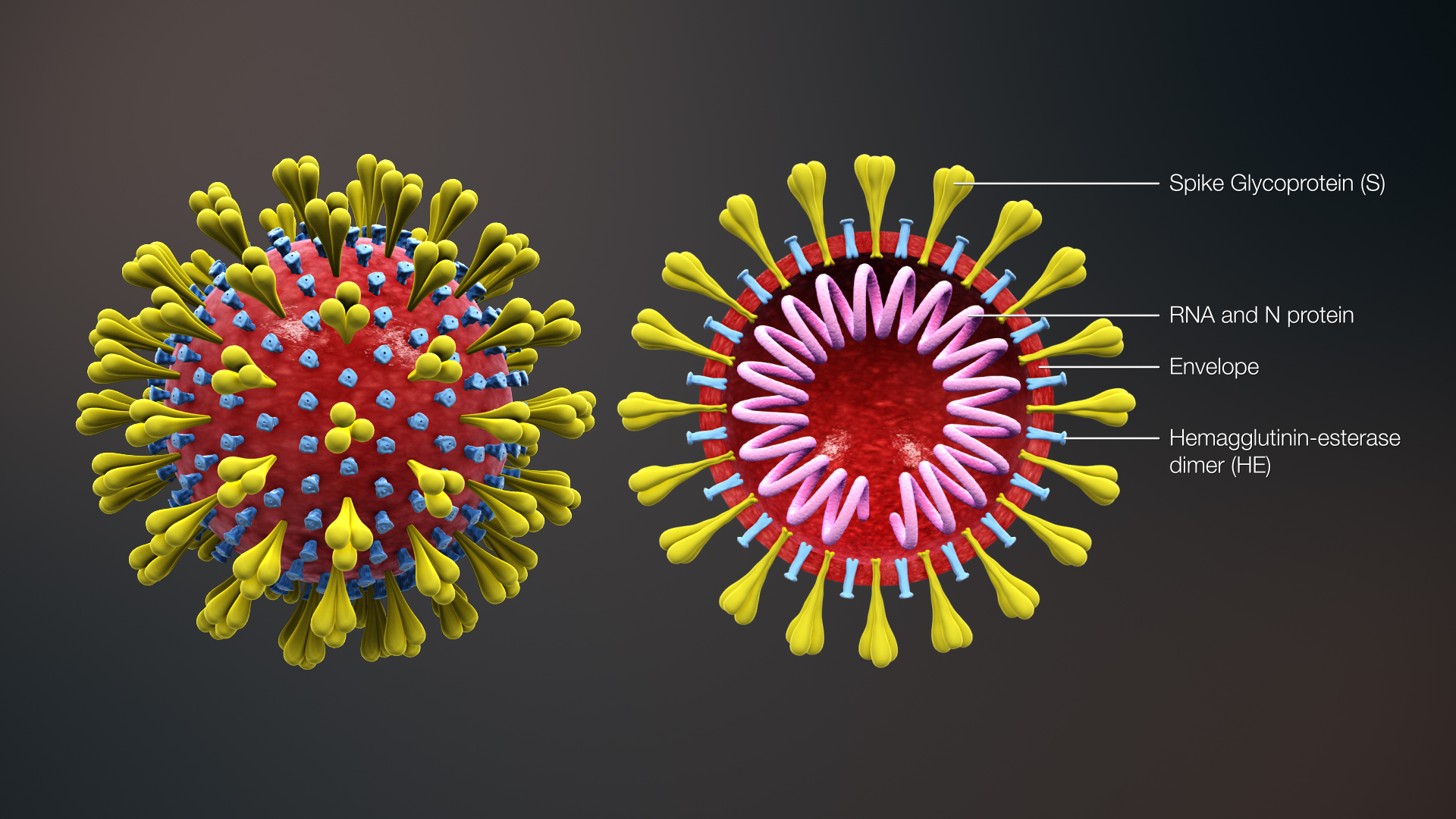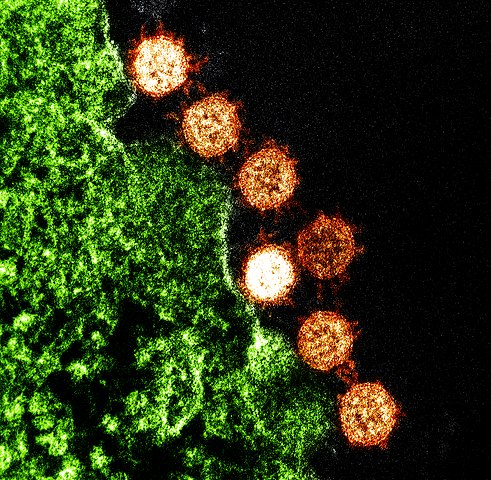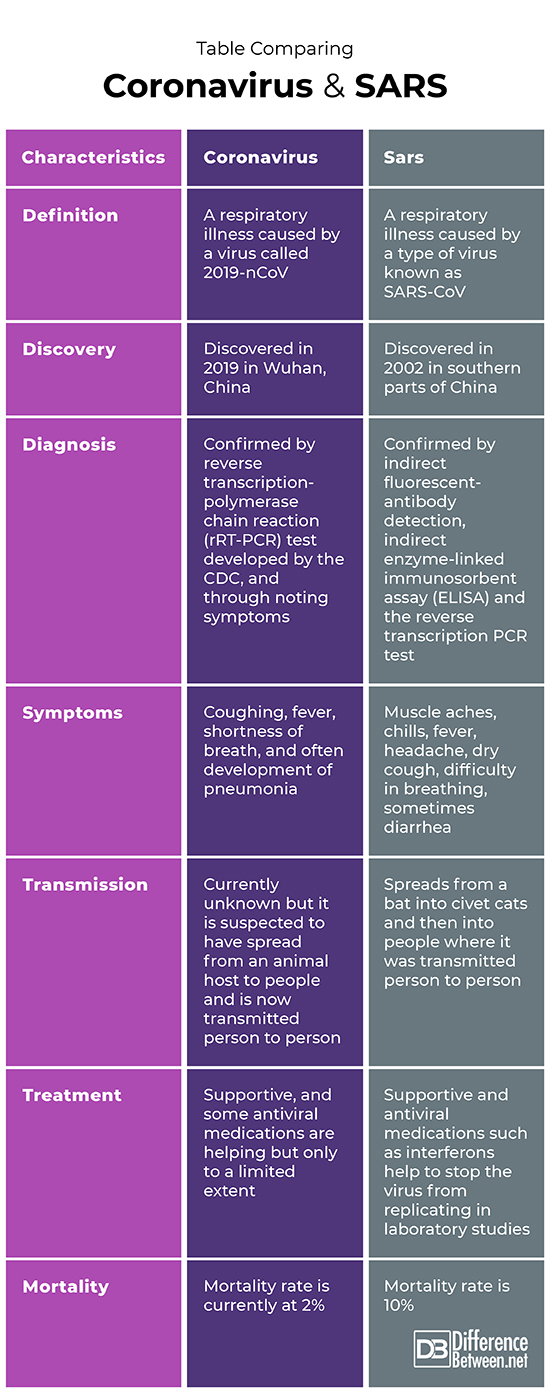Difference between Coronavirus and SARS
Coronavirus Vs. SARS
Coronavirus is a viral respiratory illness that is caused by the virus 2019-nCoV. SARS is a viral infection with respiratory symptoms that is caused by the virus SARS-CoV.
What is Coronavirus?
Definition:
Coronavirus is the name used for a new type of viral infection first noticed in Wuhan, China in 2019, which has been designated as virus 2019-nCoV. It is like SARS, a type of betacoronavirus.

Symptoms and complications:
The main symptoms are a cough, a fever, shortness of breath and in many cases the development of pneumonia. The illness causes severe symptoms and there have been fatalities with a death rate of about 2 percent so far. Individuals with chronic illnesses such as heart disease or diabetes are at greatest risk for complications and death, as are the elderly.
Diagnosis:
The diagnosis of the illness is made through a physical examination and noting of the symptoms which may appear anywhere from 2 days to 2 weeks after exposure to the virus. In addition, blood samples sent to the CDC for molecular testing allows for confirmation of the presence of the virus and confirmation of the diagnosis of 2019-nCoV.
Transmission:
The coronavirus is being spread from one individual person to another probably via respiratory droplets when a person coughs or sneezes and possibly by aerosolized fecal particles. So far, it is not known if people can contract this virus by touching infected surfaces. The host animal for this particular virus has not as yet been identified by scientists but the most cases have largely been focused around animal and seafood markets in China.
Risk factors:
People most at risk are those living in or have visited Wuhan where the illness was first detected and many people have been exposed. As of January 30, 2020, there were over 9000 cases in China alone and the WHO has declared the situation a global emergency. Other individuals at risk are those in close direct contact with people already sick with the illness, including health care professionals.
Treatment:
The treatment has mainly been supportive with most deaths being from people who were already in a weakened physical state and who had other pre-existing conditions. Some doctors have had some limited success using antiviral medications.
What is SARS?
Definition:
SARS is a severe acute respiratory syndrome, an illness caused by a type of virus known as SARS-CoV, which was first noticed in November 2002 in the southern regions of China.

SARS Virus
Symptoms and complications:
The symptoms of SARS include a dry cough, muscle aches, chills, difficulty in breathing, fever of 100.5 F (38 C), headaches and sometimes also diarrhea. Complications include pneumonia, heart and liver problems, and death in some cases.
Diagnosis:
SARS can be tentatively diagnosed by the symptoms but is confirmed by indirect enzyme-linked immunosorbent assay (ELISA) and the reverse transcription PCR test
Transmission:
SARS is transmitted between people via respiratory secretions. Thus people sneezing and coughing release droplets containing virus particles. The host animal from which the virus originated is believed by scientists to be a bat of the genus Rhinolophus that then spread the virus to civet cats from which humans became infected.
Risk factors:
People who care for patients with SARS, as well as people in direct contact, are at increased risk. However, the virus has not been detected since about 2004.
Treatment:
Much of the treatment of SARS is supportive care, yet some antivirals such as interferons have shown to help stop the virus from replicating.
Difference between Coronavirus and SARS?
-
Definition
Coronavirus is a newly discovered respiratory illness caused by a virus called 2019-nCoV. SARS is a respiratory illness caused by a type of virus known as SARS-CoV.
-
Discovery
The coronavirus was discovered in Wuhan, China in December 2019. SARS was first noticed in southern parts of China in November 2002.
-
Diagnosis
The diagnosis of coronavirus can be confirmed by means of a transcription-polymerase chain reaction (rRT-PCR) test developed by the CDC. The diagnosis of SARS can be confirmed by means of indirect fluorescent-antibody detection, indirect enzyme-linked immunosorbent assay (ELISA) and the reverse transcription PCR test.
-
Symptoms
The symptoms of coronavirus include coughing, fever, shortness of breath, and the development of pneumonia. The symptoms of SARS include chills, fever, dry cough, difficulty breathing, muscle aches, and headache.
-
Transmission
The transmission of coronavirus is not yet known but it is suspected to have spread from an animal host to people and is now transmitted person to person. The transmission of SARS is from a bat to civet cats and into people, as well as from one person to another.
-
Treatment
Treatment of coronavirus with antivirals has shown some success but mostly treatment is supportive care. Treatment of SARS is mainly supportive care, but interferon seems to stop viral replication in laboratory studies.
-
Mortality
The mortality rate of coronavirus is currently at 2%. The mortality rate of SARS is at 10%.
Table comparing Coronavirus and SARS
Summary of Coronavirus Vs. SARS
- Coronavirus and SARS are both types of viruses known as betacoronaviruses.
- Both coronavirus and SARS are respiratory infections that spread from one person to another likely through respiratory droplets.
- SARS was discovered in 2002 and has a higher mortality rate so far compared with the coronavirus that was discovered recently.
- The coronavirus in Wuhan was discovered in December 2019 and has a mortality rate of 2 out of 100 people so far.
- Antiviral medications can help to treat SARS and seems to be working against the coronavirus as well in some cases.
- Difference Between Constipation and Bowel Obstruction - April 3, 2024
- Difference Between Constipation and Diarrhea - March 30, 2024
- Difference Between Cellulite and Stretch Marks - March 25, 2024
Search DifferenceBetween.net :
 Email This Post
: If you like this article or our site. Please spread the word. Share it with your friends/family.
Email This Post
: If you like this article or our site. Please spread the word. Share it with your friends/family.
2 Comments
Leave a Response
References :
[0]Akpan, Nsikan. “new-coronavirus-spreading-between-humans-how-it-started”. National Geographic, 2020, https://www.nationalgeographic.com/science/2020/01/new-coronavirus-spreading-between-humans-how-it-started/
[1]Center for Disease Control and Prevention. “2019 Novel Coronavirus”. CDC, 2020, https://www.cdc.gov/coronavirus/2019-ncov/about/symptoms.html
[2]Martina, Byron EE, et al. "SARS virus infection of cats and ferrets." Nature 425.6961 (2003): 915-915.
[3]Image Credit: NIAID Integrated Research Facility in Fort Detrick, Maryland



this article is well out of date and now inaccurate.
it needs updating ASAP
eg up to 1 months incubation, can be passed on money and live outside body for 72 hrs. has a much higher death rate than SARS considering the information now coming out of Iran and China.
Good article.
It would be most helpful if you would add the date that this was posted.
If it is updated then the date of those updates should also be posted.